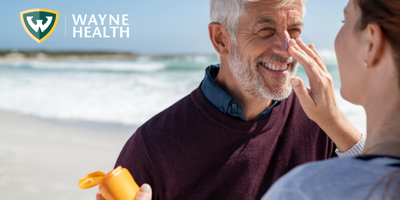Protect your skin from sunburn
July 11, 2022
Being out in the sun can be good for you. Sunlight can brighten your mood and help you feel healthier. But getting too much of the ultraviolet (UV) rays from sunlight or from indoor tanning can harm your skin. It can cause problems right away as well as problems that may develop years later.
A sunburn is skin damage from the sun’s ultraviolet A and ultraviolet B (UVA and UVB) rays. Most sunburns cause mild pain and redness but affect only the outer layer of skin (first-degree burn). The red skin might hurt when you touch it. These sunburns are mild. They can usually be treated at home.
Skin that is red and painful and that swells up and blisters may mean that deep skin layers and nerve endings have been damaged (second-degree burn). This type of sunburn is usually more painful and takes longer to heal.
You may get a more severe sunburn depending on:
- The time of day. You are more likely to get a sunburn between 10 in the morning and 4 in the afternoon when the sun’s rays are the strongest. You might think the chance of getting a sunburn on cloudy days is less, but the sun’s damaging UV light can pass through clouds.
- Whether you are near reflective surfaces, such as water, white sand, concrete, snow, or ice. All of these reflect the sun’s rays and can increase your risk of getting a sunburn.
- The season of the year. The position of the sun on summer days can cause a more severe sunburn.
- Altitude. It’s easy to get sunburned at higher altitudes. That’s because there’s less of the earth’s atmosphere to block the sunlight. UV exposure increases in elevation.
- How close you are to the equator (latitude). The closer you are to the equator, the more direct sunlight passes through the atmosphere. For example, the southern United States gets more sunlight than the northern United States.
- The UV index of the day, which shows the risk of getting a sunburn that day.
Preventive measures and home treatment are usually all that’s needed to prevent or treat a sunburn.
- Protect your skin from the sun.
- Don’t stay in the sun too long.
- Use sunscreen, and wear clothing that covers your skin.
Here are some things you can do at home for a mild sunburn.
- Use cool cloths on sunburned areas.
- Take frequent cool showers or baths.
- Apply lotions.
Lotions that contain aloe vera may feel soothing to sunburned areas. Topical steroids (such as 1% hydrocortisone cream) may also help with sunburn pain and swelling. You may need to check with your doctor first if you need to use the cream for a child younger than age 2 or for use in the genital area.
There’s not much you can do to stop skin from peeling after a sunburn. It’s part of the healing process. Lotion may help relieve the itching.
- Rest and drink fluids for a headache.
A sunburn can cause a mild fever and a headache. Lie down in a cool, quiet room to relieve the headache. A headache may be caused by dehydration, so drinking fluids may help.
To make an appointment with a Wayne Health Dermatologist, visit our appointments page.
